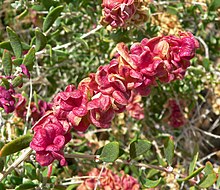Grayia (plant)
| Grayia | |
|---|---|

| |
| Grayia spinosa | |
| Scientific classification | |
| Kingdom: | Plantae |
| Clade: | Tracheophytes |
| Clade: | Angiosperms |
| Clade: | Eudicots |
| Order: | Caryophyllales |
| Family: | Amaranthaceae |
| Subfamily: | Chenopodioideae |
| Tribe: | Atripliceae |
| Genus: | Grayia Arn.
|
| Synonyms[1] | |
|
Zuckia Standl. | |
Grayia is a genus of plants in the subfamily Chenopodioideae of the family Amaranthaceae. Common names are siltbush and hopsage. The four shrubby species occur in arid and semiarid regions of western North America:[2]
Description
The species of Grayia are
The plants are
In fruit, the bracteoles enclosing the fruit become accrescent, folded along the midribs and connate nearly to the apex, 4–14 × 3–15 mm. Their shape can be orbicular, broadly elliptic, or cordate, their margins are usually entire, but sometimes wavy or extended into two wings, their surface is flat or ribbed, glabrous or hairy. Initially, bracteoles are yellowish-greenish or cream-colored, later they become reddish or pinkish. The orbicular, obovoid or laterally compressed-lenticular fruit (utricle) does not fall at maturity. The membranous
The flowering time is March to June.[1]
The chromosome numbers are 2n = 18 (for the diploid Grayia arizonica and Grayia brandegeei) and 2n = 36 (for the tetraploid Grayia spinosa and Grayia plummeri).[1]
Distribution
The genus Grayia is native in the western United States (
Systematics
The genus Grayia has been first described by
Grayia belongs to the tribe
- Grayia arizonica (Standl.) E.H.Zacharias,[1] (Syn. Zuckia arizonica Standl., Zuckia brandegeei var. arizonica (Standl.) S. L. Welsh) - Arizona siltbush: in Arizona and Utah
- Grayia brandegeei A. Gray[1] (Syn. Zuckia brandegeei (A. Gray) S. L. Welsh & Stutz) - Brandegee's siltbush: in Colorado, Arizona, Utah
- Grayia plummeri (Stutz & S.C.Sand.) E.H.Zacharias,[1] (Syn. Grayia brandegeei var. plummeri Stutz & S. C. Sand., Zuckia brandegeei var. plummeri (Stutz & S. C. Sand.) Dorn) - Plummer's siltbush: in Colorado, Wyoming, New Mexico and Utah
- Grayia spinosa (Hook.) Moq.,[1] spiny hopsage: in Colorado, Idaho, Montana, Oregon, Washington, Wyoming, Arizona, California, Nevada and Utah.
References
External links
- "Grayia". Integrated Taxonomic Information System. Retrieved 2013-07-10.
- Grayia at Tropicos
- Stanley L. Welsh (2003): Zuckia in Flora of North America
